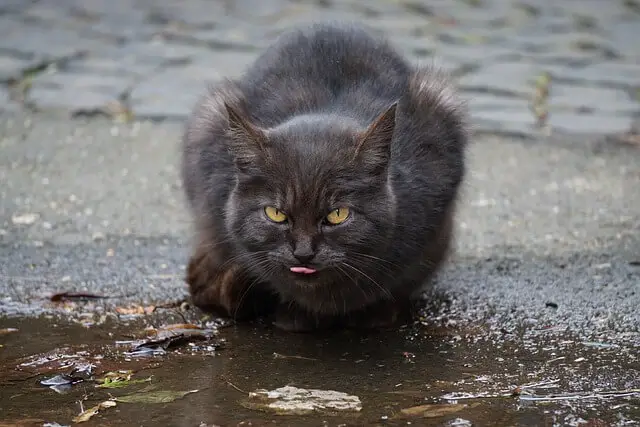The 4 Most Common Type Of Cancer in Cats & Their Treatment
16.04.2022.
There has been an increase in the number of feline cancer cases in recent years. Veterinary medicine has enhanced cats' lifespans, and cancer is typically a disease of senior cats. The term "cancer" refers to the unrestricted development of cells. Cell division is normally tightly controlled. One cell's genetic abnormalities can lead to cancer, which results in tumors when cell division becomes uncontrollable.
There are different types of cancer cats can develop, but the most common ones are;
- Lymphoma
- Squamous cell carcinoma
- Mammary (breast) cancer
- Fibrosarcoma
In this article, we'll go over the 4 most common types of cancer in cats and their treatments.
Lymphoma
Lymphoma is the most commonly diagnosed cancer type in felines. Lymphoma is a malignant tumor of lymphocytes and lymphoid tissue. Lymph nodes, spleen, liver, intestines, and bone marrow are all locations where lymphoid tissue can be found.
RELATED: Arthritis in Cats: Causes, Diagnosis & Treatment
Lymphoma has been linked to the feline leukemia virus (FeLV). Feline immunodeficiency virus, or feline AIDS, carriers are at higher risk of lymphoma than non-carriers. Affected cats might be of any age, gender, or breed.

Many different types of feline lymphoma exist based on the tumor's primary site. It's difficult to categorize certain cases because cats typically have several affected areas. The most prevalent type of lymphoma cats develop is in their digestive tract. Lymph nodes, stomach, intestines, and liver surrounding the intestines are all part of the digestive tract. Cats with this type of lymphoma can vomit, have diarrhea, lose weight, or be less hungry.
How is it treated?
Approximately 70 percent of cats treated with chemotherapy for lymphoma will experience remission. Chemotherapy is well tolerated by most cats, and side effects are rare. According to the FDA, only 5% of the cats given the medication have serious adverse effects. Nausea, vomiting, and a loss of appetite are all possible side effects, as are diarrhea, exhaustion, or infection. Their whiskers and coat texture may be impacted because of chemotherapy.
RELATED: Is Your Cat Panting? Here's What It Might Mean
Squamous cell carcinoma
The squamous cell carcinoma (SCC), or cancer of the cells lining the mouth, is the most often occurring oral tumor in cats.
If your cat has oral SCC, you may notice symptoms including excessive drooling, a bad odor, mouth bleeding, or trouble eating. Based on their symptoms, SCC may be diagnosed as the underlying cause of dental disease in some cats. A biopsy is typically required to confirm a diagnosis of SCC.
How is it treated?
SCC is best treated surgically whenever possible. Even though cats' mouths are so small, and since tumors are so massive, only 10% of cases will react to surgery successfully. In cases where surgery is an option, the tumor's capacity to penetrate bone and other deep oral structures usually necessitates the removal of portions of the cat's jaw.

RELATED: What Does Blood in Cat Urine Mean? Should I Be Worried?
Besides surgery, radiation and chemotherapy are often used as supportive treatments for this cancer type. Unfortunately, in the case of SCC, there is a very slim chance of recovery. With treatment, the goal is to extend life as long as possible while maintaining an excellent quality of life.
Mammary (breast) cancer
The mammary tumor is the most prevalent type of cancer in elderly unneutered female cats. However, it can also be seen in male cats and neutered female cats.
Several breast glands are typically affected by this tumor, which frequently results in many nodules or masses on the skin. These nodules or masses often become infected over time.
In addition to spreading to nearby lymph nodes, this cancer has been known to metastasize to the lungs.
How is it treated?
The most effective treatment for this cancer type is surgical removal at the earliest feasible moment. Surgeons may be able to remove the entire tumor if it is tiny. Chemotherapy may be used after surgery if the cancer is giant or there is evidence of lymph node involvement.
RELATED: Stomatitis in Cats: Causes, Symptoms & Treatment
Fibrosarcoma
Fibroblasts (cells that make fibrous tissue) and other supportive tissues are affected by the fibrosarcoma, which is most typically found beneath the skin.

Under the skin, these tumors often appear as progressively growing, solid masses. These tumors range from low-grade to high-grade; some are incredibly malignant with substantial tissue invasion and early lymph node and pulmonary metastasis. Those who are less aggressive are not as likely to invade and spread.
Fibrosarcoma is most commonly diagnosed by a cat's skin becoming progressively thicker and swollen over time, but this can affect various body parts.
RELATED: What Does Blood in Cat Stool Mean?
How is it treated?
Surgery is usually the first step in the treatment of fibrosarcoma. It's possible that even after surgery, the tumor will reappear. The outcome is that a combination of radiation and/or chemotherapy is often prescribed. Patients may be disease-free for up to two years if they get a combination of medications.

What if my cat has cancer?
We can now treat previously untreatable cancers thanks to recent advancements in veterinary oncology. You should know that animals' quality of life is the most crucial consideration when deciding on treatment options for cancer, and your vet will undoubtedly tell you all about it.
Cat cancer treatments are far less aggressive than treatments in humans. The good news is that significant side effects are rare. There may be current clinical trials for your cat's condition that a veterinarian oncologist can point you in the right direction.
RELATED: Kidney Failure in Cats: Causes, Symptoms & Treatment
Make sure you remain calm and do everything you can to provide your beloved pet with the best possible treatment. A cancer diagnosis doesn't mean immediate death. It is a dangerous condition, but animals generally react to treatment better than humans do. Talk to your vet, and they can tell you what the best next steps are.
World Cat Finder Team







Share